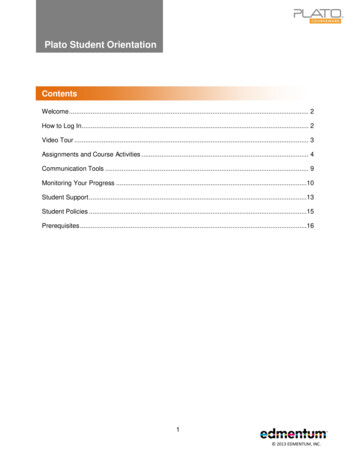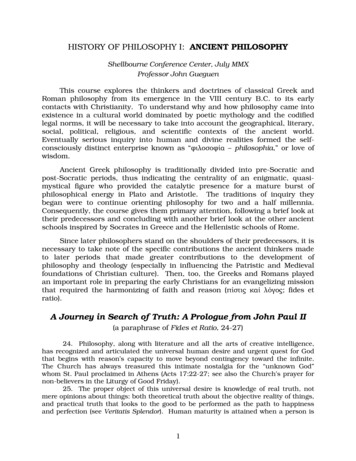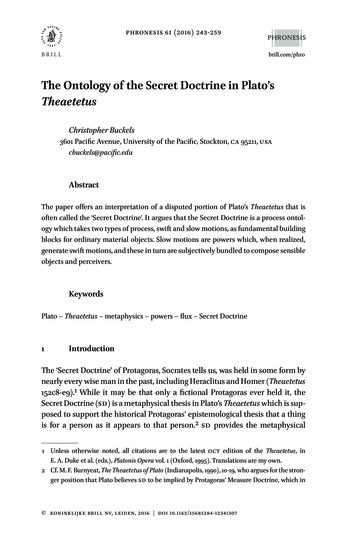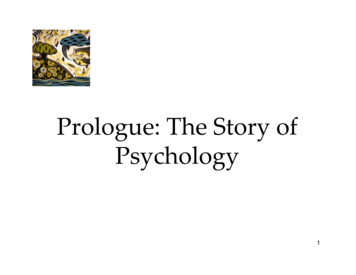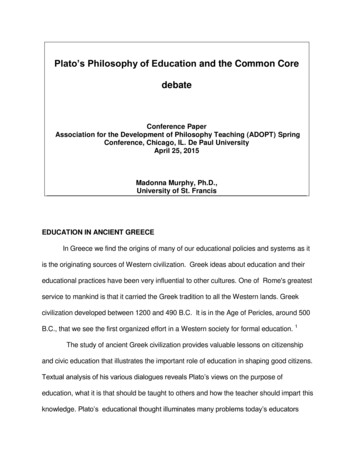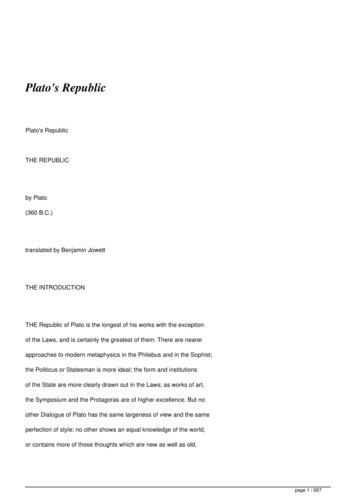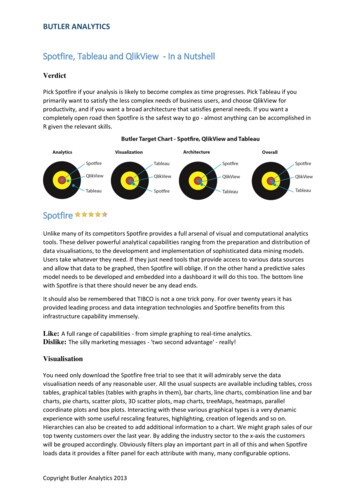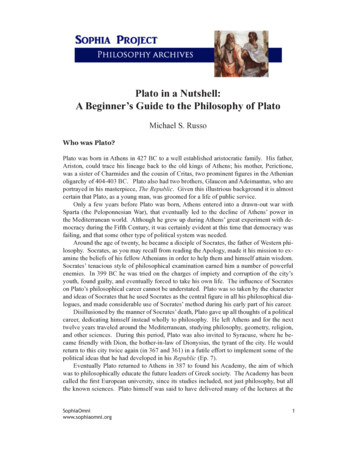
Transcription
Plato in a Nutshell:A Beginner’s Guide to the Philosophy of PlatoMichael S. RussoWho was Plato?Plato was born in Athens in 427 BC to a well established aristocratic family. His father,Ariston, could trace his lineage back to the old kings of Athens; his mother, Perictione,was a sister of Charmides and the cousin of Critas, two prominent figures in the Athenianoligarchy of 404-403 BC. Plato also had two brothers, Glaucon and Adeimantus, who areportrayed in his masterpiece, The Republic. Given this illustrious background it is almostcertain that Plato, as a young man, was groomed for a life of public service.Only a few years before Plato was born, Athens entered into a drawn-out war withSparta (the Peloponnesian War), that eventually led to the decline of Athens’ power inthe Mediterranean world. Although he grew up during Athens’ great experiment with democracy during the Fifth Century, it was certainly evident at this time that democracy wasfailing, and that some other type of political system was needed.Around the age of twenty, he became a disciple of Socrates, the father of Western philosophy. Socrates, as you may recall from reading the Apology, made it his mission to examine the beliefs of his fellow Athenians in order to help them and himself attain wisdom.Socrates’ tenacious style of philosophical examination earned him a number of powerfulenemies. In 399 BC he was tried on the charges of impiety and corruption of the city’syouth, found guilty, and eventually forced to take his own life. The influence of Socrateson Plato’s philosophical career cannot be understated. Plato was so taken by the characterand ideas of Socrates that he used Socrates as the central figure in all his philosophical dialogues, and made considerable use of Socrates’ method during his early part of his career.Disillusioned by the manner of Socrates’ death, Plato gave up all thoughts of a politicalcareer, dedicating himself instead wholly to philosophy. He left Athens and for the nexttwelve years traveled around the Mediterranean, studying philosophy, geometry, religion,and other sciences. During this period, Plato was also invited to Syracuse, where he became friendly with Dion, the bother-in-law of Dionysius, the tyrant of the city. He wouldreturn to this city twice again (in 367 and 361) in a futile effort to implement some of thepolitical ideas that he had developed in his Republic (Ep. 7).Eventually Plato returned to Athens in 387 to found his Academy, the aim of whichwas to philosophically educate the future leaders of Greek society. The Academy has beencalled the first European university, since its studies included, not just philosophy, but allthe known sciences. Plato himself was said to have delivered many of the lectures at theSophiaOmniwww.sophiaomni.org1
Academy, although the notes from these lectures were never published. Among the mostfamous students of the Academy was Aristotle, who would later go on to found his ownschool, the Lyceum. Plato’s Academy would continue to educate Athenian noblemenfor several centuries, influencing most of the major philosophical schools of the Westernworld. Plato died at the age of 80 in 347 BC.Plato’s DialoguesMost of Plato’s philosophical writing takes the form of dialogues. It is believed that allforty-two of the dialogues that Plato wrote have survived. These dialogues were writtenfor educated laymen (as opposed to the elite in his academy) in order to interest them inphilosophy (Taylor 10). To sum up their common characteristics, Plato’s dialogues: are philosophical discussions between two or more participants.usually focus on a specific theme: e.g., justice, friendship, piety.are written for the most part like regular conversations, which often include digressions and frequently are inconclusive.Plato’s dialogues are not just great works of philosophy; they are also recognized asgreat literary works as well. He goes to much effort to carefully set the scene of each dialogue and to develop the personalities of each of the characters in them. One is frequentlyamazed at just how dramatic many of these dialogues are, considering their lofty topics.Plato’s dialogues can be divided into three periods:Early DialoguesApologyCritoLachesEuthyphroRepublic, Book 1Middle DialoguesGorgiasMenoEuthydemusHippias I and IICratylasLate DialoguesSymposiumPhaedoRepublic, Books 2-10TimaeusLawsAs has already been pointed out, Plato uses Socrates as the main interlocutor in hisdialogues. The specific way that Plato makes use of the character of Socrates varies somewhat during the different periods in which Plato wrote.In the early dialogues the Socrates that Plato presents to the reader is probably closeto the historic Socrates. Socrates is portrayed in these dialogues as precisely what he wasin real life—a gadfly, whose aim was to make people recognize that many of their beliefsare baseless. The Socrates of these early dialogues claims to be ignorant of everythingexcept his own ignorance, and as such rarely presents his own position on the topics beingdiscussed. Plato’s aim, then, in these early dialogues primarily, is critical: that is, to tearapart the inadequate moral views of others.In the middle dialogues, Plato is coming into his own as a philosopher and is startingto develop some of his own metaphysical and epistemological positions. It is during thisperiod that Plato begins to introduce his theory of the forms into his writings. In the latedialogues, Plato uses Socrates almost exclusively to advance his own views. His approachin these dialogues is essentially constructive—that is, to develop his own mature philoSophiaOmniwww.sophiaomni.org2
sophical system.The Republic is an interesting work because in it we get the best of both the early andlater dialogues. Book one is written as a traditional dialogue in which Socrates is represented in a fairly historical way, critically reacting to the views of others in the dialogue.But the rest of the text (Books 2-10) is much more of a monologue in which Socrates servesas little more than a mouth-piece for Plato’s own political views.Plato’s MetaphysicsTo understand Plato’s worldview, it is important to grasp the distinction that he makesbetween sensible “things” and “forms.”Things are those aspects of reality which we perceive through our senses: a tree, a car,a table, chair, a beautiful model, etc. Everything that we experience in the world of sensation is constantly changing (the table will start to get worn down, the beautiful model willage with time), imperfect and often fleeting. This is the realm of appearances, and we allknow that appearances can be deceptive.Whereas things change, decay, and ultimately fade away, the Forms (the Greek termis Eidos which is sometimes translated as Ideas) are eternal and unchanging. This is therealm of perfect concepts and is grasped, not by the senses, but by the reason.Thus, for Plato there are two fundamental aspects or realms of reality—the realm of thesenses and the realm of the forms. These two realms can be contrasted in the followingway:Sensible Worldappearance (seems real)immanent (within space and time)World of the Formsappearance (seems real)transcendent (beyond space and time)becoming (ever changing)particular and imperfectmany instances (copy; imitation)perceived by sensessubjective (dependent upon my perception)eg., a table, a just act, a beautiful model, acircle, Suebeing (eternal and unchanging)absolute and perfectone essence (archetype)known by reasonobjective (exist independently of my mind)e.g., Table, Justice, Beauty, Circle, ManFor Plato it is the world of the Forms (the realm of being) that is “really real” world;the world that we perceive with our senses (the realm of becoming) is little more than animitation of this ultimate reality. He believes that for particular and imperfect thing thatexists in the sensible realm (a table, a just act, a beautiful model, a circle) there is a corresponding absolute and perfect Form (Table, Justice, Beauty, a Circle).In order to explain how sensible things come into being, Plato relies on the idea ofparticipation. A table comes into being, he believes, because it participates in the form ofTableness. In the Phaedo Plato uses the metaphor of participation to explain the existenceof particular beautiful things:It seems to me that whatever else is beautiful apart from absolute beauty isSophiaOmniwww.sophiaomni.org3
beautiful because it partakes of that absolute beauty, and for no other reason. Doyou accept this kind of causality?Yes, I do.Well, now, that is as far as my mind goes; I cannot understand these otheringenious theories of causation. If someone tells me that the reason why a givenobject is beautiful is that it has a gorgeous color or shape or any other such attribute, I disregard all these other explanations—I find them all confusing—and Icling simply and straightforwardly and no doubt foolishly to the explanation thatthe one thing that makes the object beautiful is the presence in it or associationwith it, in whatever way the relation comes about, of absolute beauty. I do not goso far as to insist upon the precise details---only upon the fact that it is by beautythat beautiful things are beautiful. This, I feel, is the safest answer for me or anyone else to give, and I believe that while I hold fast to this I cannot fall; it is safefor me or for anyone else to answer that it is by beauty that beautiful things arebeautiful. Don’t you agree? (100c-e)But why did Plato need to devise such an elaborate metaphysical system to ground hisethics? The answer seems to be that he is trying to respond to the relativism of the Sophists, who were persuasively arguing that true and false, good and bad, were simply mattersof opinion. Plato clearly recognized that if this kind of relativism was accepted that itwould lead to the death of philosophy and all legitimate attempts at moral discourse.To save the philosophical enterprise, Plato had to devise an idea of truth and goodnessthat was independent of individual perceptions of truth and goodness. Thus he needed toanchor these concepts in a transcendent realm—the world of the forms.While the Sophists, then, would maintain that there potentially could be as many legitimate ideas of justice or beauty as there are individuals, for Plato there is Justice andBeauty—objective and transcendent realities that have nothing to do with my individualperceptions or opinions.Plato’s Analogies: The Sun, The Divided Line and the CaveIf Plato’s metaphysics strikes you as being difficult to grasp, you’re definitely not alone.The highly abstract nature of Plato’s theory has probably frustrated students since he firstdeveloped it. Perhaps recognizing this, in the Republic Plato resorts to using three analogies to illuminate his philosophy. A brief examination of these analogies is definitely inorder before examining Plato’s discussion of them in the Republic.In the first of these analogies, Plato compares the Form of the Good with the sun. Justas the sun provides the light that is necessary for us to see things in the sensible realm, sodoes the Form of the Good provide the intellectual light that enables us to know the Forms.This comparison can be summed up in the following way:SourceThe SunProvides.lightWhere?in the sensibleworldSophiaOmniwww.sophiaomni.orgIn Orderto.seeWhat?visible things(the sensible)4
The “Good”intellectual lightin the intelligible knowworldinvisible things(the forms)Plato also believes that just as the sun causes things in the sensible world to exist andsustains them, so too does the Good cause the forms to be. Plato’s Form of the Good, then,is the ultimate principle of reality and truth and is the source of all order, harmony, beautyand intelligibility in the universe.The Two World’s Theory lays the foundation for understanding the two realms ofreality—the sensible world and the world of the forms—that are at the heart of Plato’smetaphsics. In Book 6 of the Republic, however, Plato goes one step further by dividingeach of these realms into additional subdivisions:The Sensible Worldimages of sensiblethingssensible thingsreflections, paintings, photosa chair, a table, ajust act, a beautifulpersonThe World of the Formsmathematical forms higher forms(table, circle, human)table, circle, human Justice, Beauty(based on sensible(purely abstract)things)Plato argues that each of these four aspects of reality—images, things, mathematicalforms and higher forms—must be grasped by a different faculty of the mind. We nowmove from metaphysics (the study of the nature of reality) to a different but related branchof philosophy—epistemology. Epistemology seeks to understand how we know or graspthat which exists in reality.In an attempt to illustrate his epistemological system, Plato gives us his famous imageof the divided line. The line is divided into four parts signified by the main horizontal andvertical lines:SophiaOmniwww.sophiaomni.org5
According to Plato’s understanding, everything below the horizontal line represents thesensible world; everything above it, the world of the forms. Plato means us to proceedfrom the bottom to the top, from images to higher forms, from the lowest level of realityto the highest.Plato divides the image further by introducing the vertical line. Everything on the lefthand side of the vertical line represents particular dimensions of reality within the sensibleworld and the world of the forms. Everything on the right hand side represents the particular faculties one uses to grasp the corresponding dimension of reality. Thus one usesimagination to grasp images, perception to grasp sensible things, and so on. The higher upone goes on the right-hand side of the image the greater the degree of intellectual certaintyone attains. Thus the highest degree of certainty is attained by using our understandingwhich enables us to grasp higher forms.In some ways, Plato’s entire philosophy can be summed up in his most famous analogy—the allegory of the Cave. Plato has us image an underground cave, in which a groupof prisoners are chained and able to see only what is in front of them. Behind the prisonersis a fire in front of which men walk carrying objects that cast shadows on the walls of thecave. Since all they’ve been exposed to are these images, the prisoners naturally come tothink that the shadows on the wall are in fact reality. But in a dramatic twist, Plato has oneof the prisoners escape and escape from the darkness of the cave. At first, he is blinded bythe bright light of the sun, but after his eyes adjust he comes to realize that what he is experiencing outside the cave is reality, and all he thought was real was mere illusion. Feelingpity for his fellow prisoners, he goes back in the cave to try to liberate them. In the end,the other prisoners kill the one who is trying to free them, so convinced are they that theshadows they experience inside the cave are the only true reality.SophiaOmniwww.sophiaomni.org6
The allegory of the cave ties together all of the other analogies that Plato uses to explain his worldview. Those who are enamored with the world of images are like the prisoners in the cave, completely caught up with images they perceive to be real. The manwho breaks free of his chains is the philosopher who, using his intellect ascends out of thecave (out of the world of the senses and into the world of the forms). Plato believes thatthe true philosopher—and we should think of Socrates here—would elect to return to theworld of the senses to try to liberate his fellow man, even though he naturally would preferto remain permanently in the world of the forms and would face persecution and possibledeath for doing so.Plato on the Good LifeWhile all this discussion about the world of the forms vs. the sensible world and knowledge vs. opinion might seem fairly esoteric, it actually serves a fairly practical function inPlato’s philosophy. You see, Plato was convinced that as long as human beings remainedfixated on the sensible realm with imperanance and imperfections, there really was nohope that they’d ever attain true happiness in life. Only by using philosophical understanding could we break free of the illusions perpetuated by sensible things and grasphigher forms such as Beauty, Truth, and Goodness that are the source of both moralityand happiness.In a sense, what Plato was doing in his philosophy was building upon the insights ofhis intellectual mentor, Socrates. Socrates, as we have seen, believed that virtue was thekey to the good life. Plato’s insight—or mistake, depending upon how you view it—was toreason that true virtue was impossible as long as one was fixated on the transient goods ofthe sensible realm. The World of the Forms was his way of ensuring that virtue and goodness remained grounded in a Good that was beyond space and time and, therefore, eternaland incorruptible.For Further ReadingAnnas, Julia. An Introduction to Plato’s Republic. Oxford: Oxford University Press,1981.Cross, R.C. and Wooozley, A.D. Plato’s Republic: A Philosophical Commentary. London: Macmillan, 1964.Gosling, J.C.B. Plato. London: Routledge and Kegan Paul, 1973.Irwin, Terence. Plato’s Ethics. New York: Oxford University Press, 1995Kraut, Richard, ed. Cambridge Companion to Plato. Cambridge: Cambridge UniversityPress, 1992.—., ed. Plato’s Republic. Lanham, MD: Rowman and Littlefield, 1997.Nehmas, Alexander. “Plato on the Imperfection of the Sense World.” American Philosophical Quarterly 12 (1975): 105-117.Reeve, C.D.C. Philosopher-Kings. Princeton: Princeton University Press, 1989.Ross, W.D. Plato’s Theory of Ideas. London: Oxford University Press, 1951.Santas, Gerasimos. “The Form of the Good in Plato’s Republic.” Philosophical Inquiry 2(1980): 374-403.Vlastos, Gregory. Plato: A Collection of Critical Essays. 2 Vols. Garden City, NY: AnSophiaOmniwww.sophiaomni.org7
chor Books, 1970-1971White, Nicholas P. Plato on Knowledge and Reality. Indianapolis, IN: Hackett, 1976.—. A Companion to Plato’s Republic. Indianapolis, IN: Hackett, 1979. Michael S. Russo, 2001. This text is copyright. Permission is granted to print out copies for educationalpurposes and for personal use only. No permission is granted for commercial use.SophiaOmniwww.sophiaomni.org8
SophiaOmni 1 www.sophiaomni.org Plato in a Nutshell: A Beginner’s Guide to the Philosophy of Plato Michael S. Russo Who was Plato? Plato was born in At
